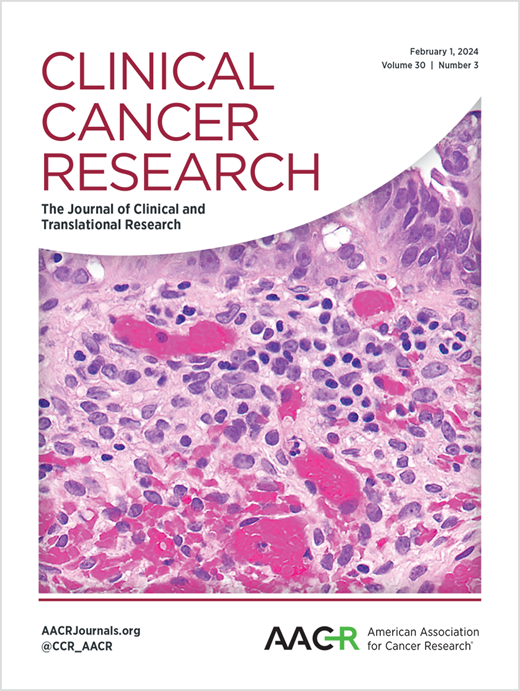Proliferation of tumor-related regulatory T cells in circulation dictates efficacy of chemoimmunotherapy in triple-negative breast cancer
IF 10.2
1区 医学
Q1 ONCOLOGY
引用次数: 0
Abstract
Purpose: PD-1/PD-L1 blockade modulates the responses of T cells including regulatory T (TREG) cells. Understanding the changes of TREG cells upon PD-1/PD-L1 blockade in cancer patients and their association with therapeutic response will provide clues regarding the mechanisms underlying resistance to treatment. Experimental Design: Peripheral blood samples were acquired before and at 1-week post-treatment from 65 patients (triple-negative [TN], n = 35; luminal, n = 30) enrolled in KORNELIA phase 2 trial, which evaluated the efficacy of chemoimmunotherapy combining nivolumab and eribulin in HER2 negative breast cancer (BC) patients. Immunophenotype of circulating immune cells was analyzed using flow cytometry. T-cell receptor sequencing was used to track the clonotypes of circulating TREG cells in relation to the tumor-related clonotypes. Results: In both breast cancer subtypes, chemoimmunotherapy increased the proportion of circulating TREG cells as well as their proliferative response. Notably, we observed an increased frequency of the circulating TREG-cell population with tumor-related clonotypes after treatment in TNBC. Moreover, increased proliferation of circulating TREG cells was associated with poor response to treatment, only in TNBC. This association between circulating TREG-cell proliferation and poor clinical response was further supported by analysis of publicly available single-cell transcriptomic data from TNBC patients. A TREG-cell-based biomarker predicted both clinical response and survival outcomes in TNBC. Conclusions: Our results indicate that the proliferation and expansion of tumor-related clonotypes among circulating TREG cells are related to chemoimmunotherapy resistance particularly in TNBC.循环中肿瘤相关调节性T细胞的增殖决定了三阴性乳腺癌化疗免疫治疗的疗效
目的:PD-1/PD-L1阻断可调节包括调节性T (TREG)细胞在内的T细胞的应答。了解癌症患者PD-1/PD-L1阻断后TREG细胞的变化及其与治疗反应的关系,将为研究耐药机制提供线索。实验设计:在KORNELIA 2期试验中,选取65例患者(三阴性[TN], n = 35; luminal, n = 30),在治疗前和治疗后1周采集外周血样本,评估纳武单抗联合艾瑞布林化疗免疫治疗HER2阴性乳腺癌(BC)患者的疗效。用流式细胞术分析循环免疫细胞的免疫表型。t细胞受体测序用于追踪循环TREG细胞的克隆型与肿瘤相关的克隆型。结果:在两种乳腺癌亚型中,化疗免疫治疗增加了循环TREG细胞的比例及其增殖反应。值得注意的是,我们观察到TNBC治疗后循环treg细胞群与肿瘤相关克隆型的频率增加。此外,循环TREG细胞增殖增加与治疗反应差有关,仅在TNBC中。循环treg细胞增殖与不良临床反应之间的关联进一步得到了来自TNBC患者的公开单细胞转录组学数据分析的支持。treg细胞为基础的生物标志物预测TNBC的临床反应和生存结果。结论:我们的研究结果表明,循环TREG细胞中肿瘤相关克隆型的增殖和扩增与化学免疫治疗耐药性有关,特别是在TNBC中。
本文章由计算机程序翻译,如有差异,请以英文原文为准。
求助全文
约1分钟内获得全文
求助全文
来源期刊

Clinical Cancer Research
医学-肿瘤学
CiteScore
20.10
自引率
1.70%
发文量
1207
审稿时长
2.1 months
期刊介绍:
Clinical Cancer Research is a journal focusing on groundbreaking research in cancer, specifically in the areas where the laboratory and the clinic intersect. Our primary interest lies in clinical trials that investigate novel treatments, accompanied by research on pharmacology, molecular alterations, and biomarkers that can predict response or resistance to these treatments. Furthermore, we prioritize laboratory and animal studies that explore new drugs and targeted agents with the potential to advance to clinical trials. We also encourage research on targetable mechanisms of cancer development, progression, and metastasis.
 求助内容:
求助内容: 应助结果提醒方式:
应助结果提醒方式:


